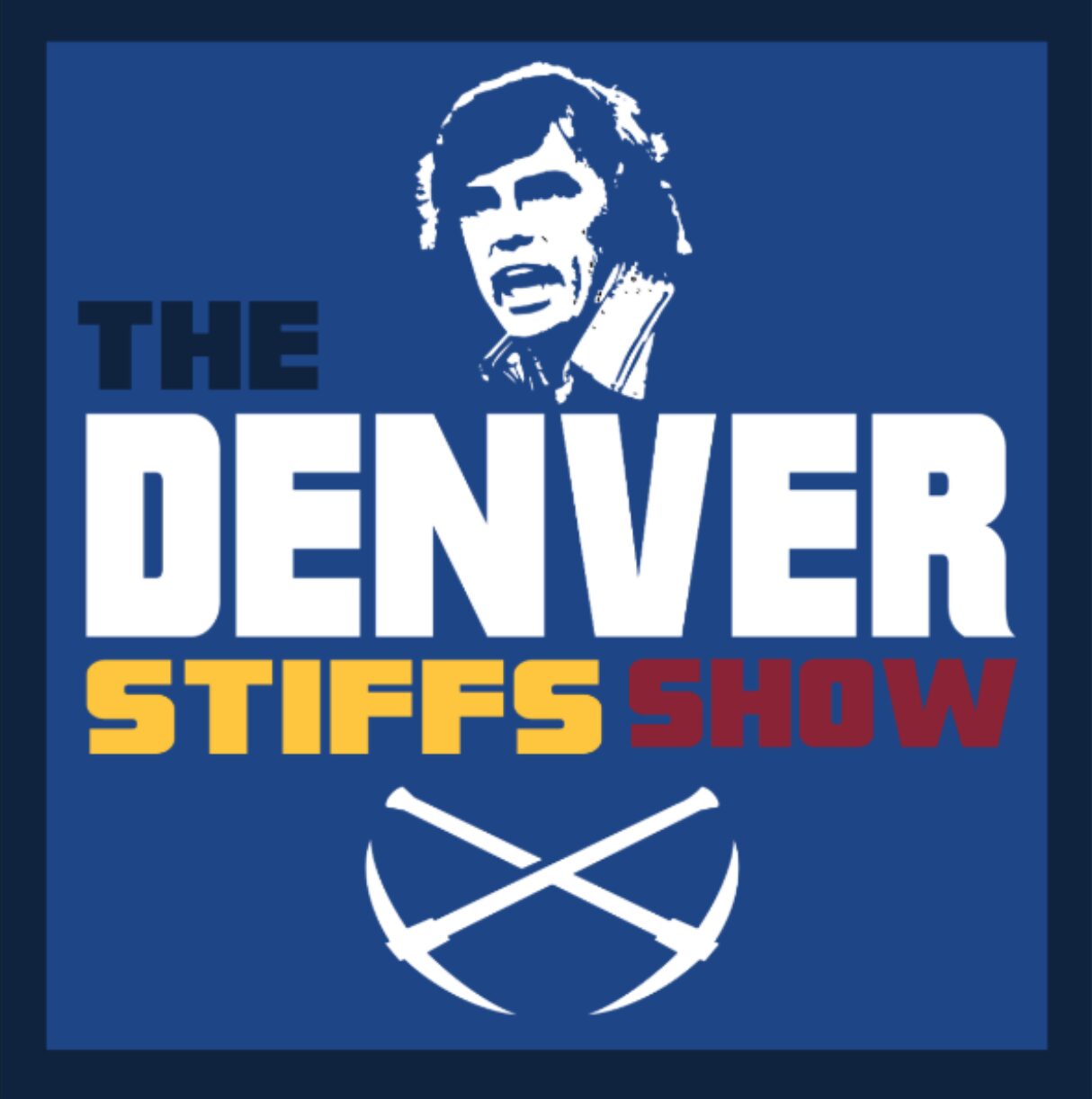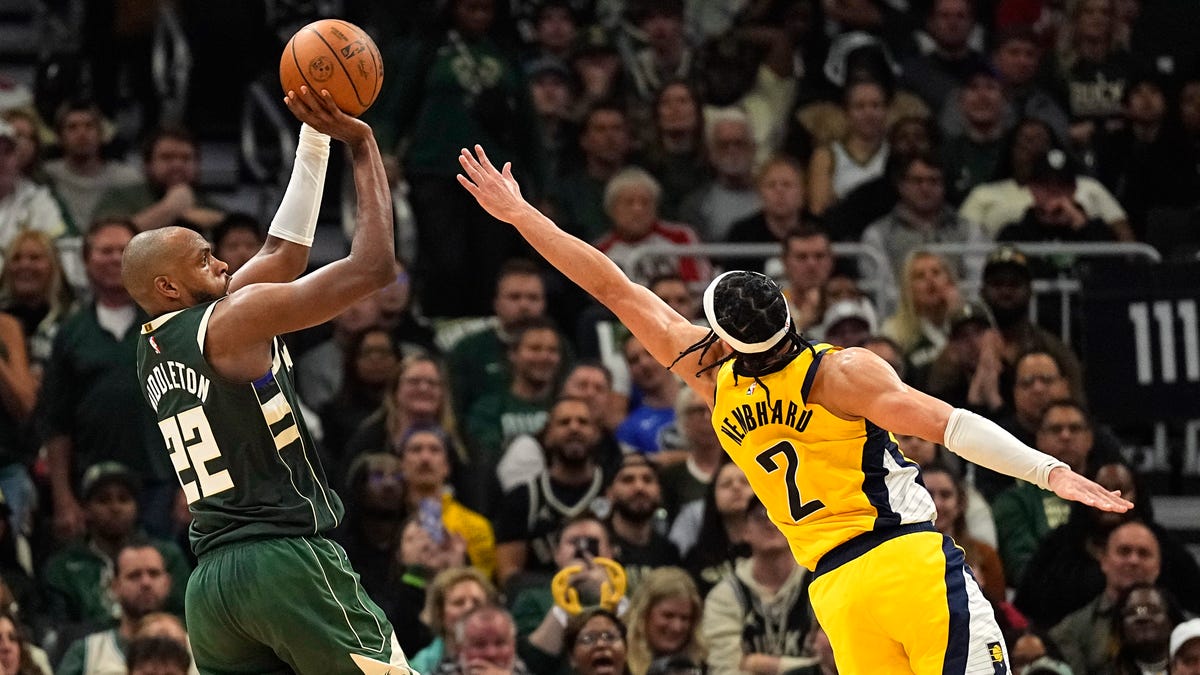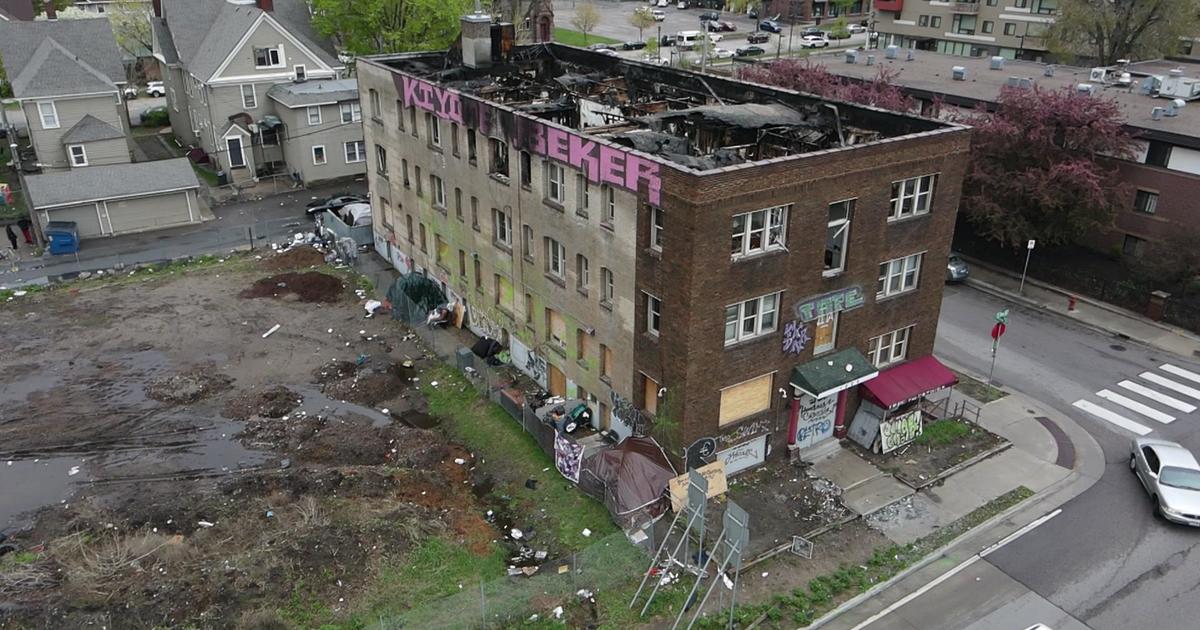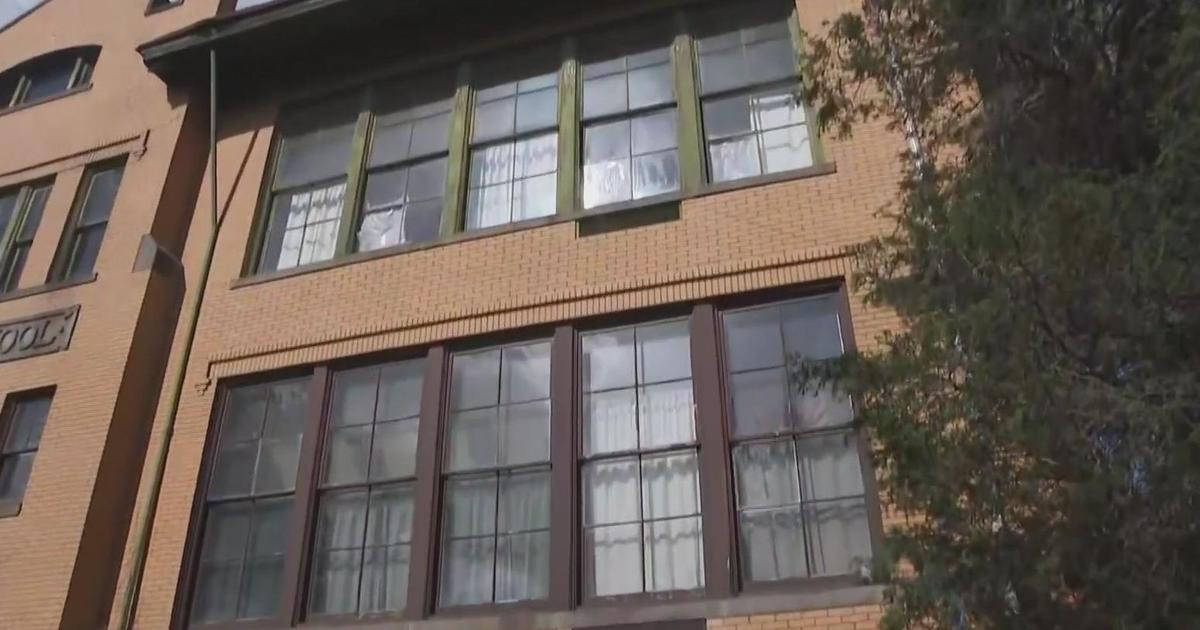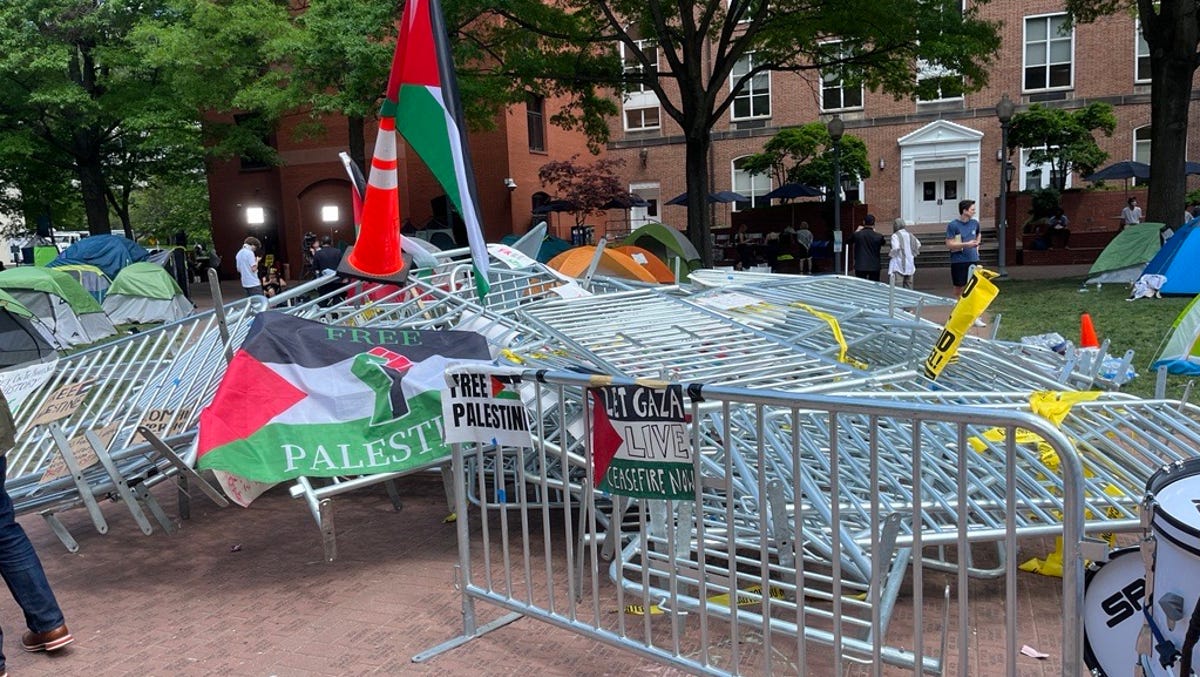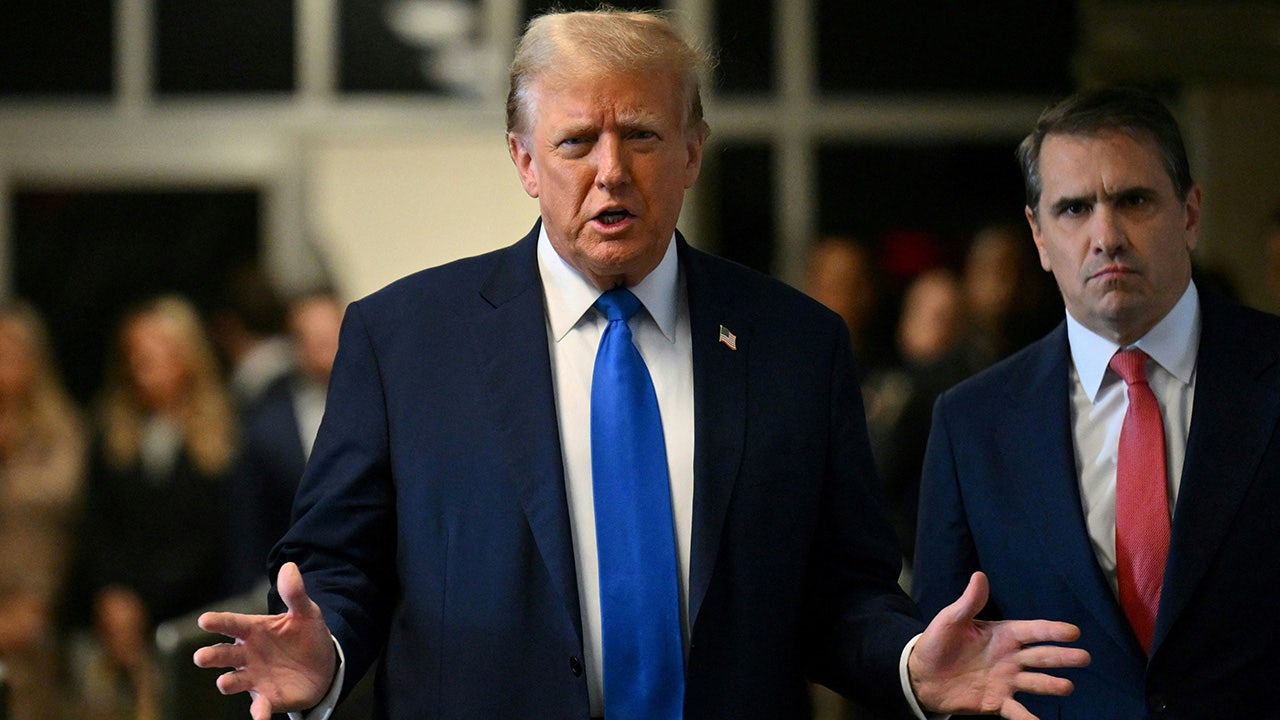Sports
How a Brazilian coach is transforming Rudy Gobert into an offensive threat

Rudy Gobert knows what is coming. He knows that a fourth NBA Defensive Player of the Year award is almost assuredly his after being the best defensive player on the best defensive team all season long.
He also knows that will do nothing to quiet the legion of skeptics who are ready to pile on should he fail to break through in the playoffs.
Gobert is one of the NBA’s great development stories, the gangly teen who has morphed into a chiseled All-Star. The former 27th pick who played in the D-League as a rookie before blossoming into a generational defender. But he remains one of the league’s biggest targets from those who believe he doesn’t have the offensive skill to merit all the money and accolades that have come his way.
Now that the playoffs are here, the scrutiny will only increase. Gobert’s third-seeded Minnesota Timberwolves face the sixth-seeded Phoenix Suns in the first round, beginning with Game 1 at 2:30 p.m. (CT) Saturday in Minneapolis. The Suns like to play small, a lineup construction that has given Gobert’s teams difficulty in past postseasons and three decisive victories over the Wolves in this regular season.
Four years ago, Gobert set out on a mission to refine his game. The hunger to be more than just a defensive stalwart brought him to a Brazilian coach who specializes in neuroscience and cognitive development. The work the pair have been doing together has Gobert — and his teammates — feeling more confident than ever in his ability to punish teams offensively as the Wolves look for their first playoff series win in 20 years.
“I think when the playoffs come, teams are going to try to adjust to what I do,” Gobert said. “I think being able to have these little extra weapons is going to be key for us.”
Take a look at Gobert’s basic counting stats — 14.0 points, 12.9 rebounds, 1.3 assists, 66.1 percent field-goal shooting — and there isn’t a real noticeable difference from most of his 11-year career. Dive deeper into his shooting profile, finishing package and expanded role in the Timberwolves offense and a different story starts to unfold.
Gobert is earning more and-1 opportunities by learning how to finish through contact and scoring more unassisted baskets thanks to an improved handle. And if that isn’t enough, the teammates who would occasionally wince at a dropped pass or grit their teeth at a turnover during a challenging first season in Minnesota have given him a much warmer embrace this season.
“I think trusting Rudy,” Anthony Edwards said earlier this month when asked about the difference between last season’s 42-win team and the one that won 56 games this season. “I think that’s the main thing. However many players on the team that plays … we all trust Rudy, like, together.”
Fernando Pereira may have envisioned Gobert earning the trust of different teammates when they began working together while with the Utah Jazz in 2020, but the results are exactly what he believed could happen. Using unconventional drills aimed at targeting the neuropathways of the brain, Pereira and Gobert have worked on sharpening his fluidity, decision-making, anticipation and reaction time.
Compared to the first season the two worked together in 2020-21, Gobert’s turnovers are down 10 percent, assists are up 26 percent and the amount of field goals he has made after taking two dribbles is up 64 percent since 2019.
“This is the future of sports,” Pereira said.
Their unique work together is about to face its biggest test. If Gobert and Karl-Anthony Towns cannot make the Suns pay for playing small, the Timberwolves will be in big trouble. This is the moment for which he and Pereira have been waiting.
Pereira grew up playing basketball in Belo Horizonte, Brazil. He was not the most athletic player on his teams but always found that his understanding of the game helped him get by. He played for the Brazilian U18, U17 and U16 national teams as a kid and spent 18 months playing professionally before earning a bachelor’s degree in physical education and a master’s degree in materials engineering while also doing post-graduate education emphasizing motor control, learning and development and a specialization in the neuroscience of movement.
Pereira quickly became interested in neuroscience and set out to learn how the brain processes information and interacts with the body. He saw how players such as Denver’s Nikola Jokić and Luka Dončić of the Dallas Mavericks controlled games with their minds as much as with their considerable physical skills, and a philosophy started to form.
“The brain of each guy is the secret,” Pereira said. “Sure, Jokić is unbelievable. He’s also slow. This is a neuroscience of revolution. Jokić, bro, he doesn’t jump. He doesn’t run. But his decision-making, his brain skills are unbelievable.”
Pereira noticed that most coaches address player weaknesses by running them through single-skill drills over and over again. In conventional circles, repetition is what yields improvement. But Pereira started to tailor drills to improve a player’s coordination and anticipation, to overloading his senses to force him to make quicker decisions.
For instance, Pereira, who goes by the nickname “Nandes,” might have a player not just attempt a turnaround jumper or layup near the rim. He might stand behind the player, toss a ball into the air as soon as the player turns and require that player to first hit the ball in the air before shooting his ball. Or he might have a player dribble with one hand and keep a balloon afloat with his other. Drills like these focus on decision-making and hand-eye coordination and getting the entire body to work in concert with the brain.
Pereira’s theory is that the basketball environment a player finds himself in during a game changes quickly. If a player is driving to the basket, defenders can move in front of him in the blink of an eye. Maybe one on the perimeter swipes at the ball as he goes by. So drills should throw multiple stressors, forcing the brain to process different stimuli quickly and help the player adapt on the fly.
While in Brazil, Pereira befriended Raul Neto, who spent eight years in the NBA with the Utah Jazz, Philadelphia 76ers, Washington Wizards and Cleveland Cavaliers. Neto saw some of those unique concentration drills and asked Pereira to come back to the United States to watch games and practices during Jazz training camp in 2017.
It was there that Pereira met Jazz coach Igor Kokoškov, an assistant on Quin Snyder’s staff. Neto told Kokoškov about Pereira’s coaching techniques, and Kokoškov was intrigued. He recalled asking Pereira what he thought after watching his first NBA game. Pereira told him he watched the players closely from the time they arrived at the arena, to getting dressed, getting their ankles taped, eating a pregame meal and going through warmups.
“You guys touched everything. Everything but the brain,” Pereira told Kokoškov. “The brain is still sleeping. After the jump ball, your brain has to be ready to react. That’s something you guys didn’t do at all.”
Kokoškov, now an assistant under Snyder with the Atlanta Hawks, paused as he thought back to what he said was a “life-changing” meeting in his NBA coaching career.
“That was an interesting point of view,” he said.
Kokoškov invited him to dinner and then asked to watch Pereira put Neto and point guard Ricky Rubio through a workout the next day. That turned into an invitation to attend practices in the preseason.
“That changed my life,” Pereira said. “Because Igor was curious to know more.”
Kokoškov spent one season as head coach of the Phoenix Suns in 2018-19 and brought Pereira in again for the preseason to work with his players and coaches. Pereira worked directly with Devin Booker and Mikal Bridges and also went about trying to convince the rest of the coaching staff that neurology played an important role in player development. It has not always been easy.
Gobert hears skeptics in the NBA media world. Pereira runs into them in the coaching fraternity.
“It’s a revolution. A revolution changes things around us and people are skeptical and afraid,” Kokoškov said. “We’re all territorial, especially in big operations like the NBA. We’re just fighting for our territory and any unknown territory for us as coaches, we’re resisting.”
Pereira was back coaching and teaching in Brazil in 2019 when he decided to take a chance. He left his job and took a student visa to the U.S., enrolling in English classes in Salt Lake City. Kokoškov arranged a meeting with Snyder, who was still coaching the Jazz, for Pereira to present his theory and showcase his drills.
Snyder was convinced. He brought Pereira in and had him start to work with the Jazz G League players. Gobert took notice of the work Pereira was doing with the players. Neto also recommended him to Gobert, opening the door for collaboration.
In Gobert, Pereira found what he needed — a willing learner. Players can be skeptical of approaches as different and complex as those that Pereira employs. But Gobert has always been intellectually curious. There is always a book in his locker. His is a mind more open to the abstract. Some eyes would glaze over when Pereira would start to educate on cognitive responses in the brain. Gobert leans into it, searching to understand why things are different for him than some other players.
“I enjoyed it because there was also a challenging aspect to it,” Gobert said of his early days with Pereira. “It’s not like you just do 100 hook shots. You’ve been challenged and it challenges your brain to be put in different situations, which, I think for me, was what I needed.”
Looking to make his strides during the pandemic, when players were limited to one-on-one interactions with coaches, Gobert hired Pereira to start the 2020-21 season.
They set out on a plan together, focusing on Gobert’s decision-making, scoring versatility and fluidity of movement. The early days of the partnership laid clear how much work there was to be done. Pereira started to use soccer-based drills to get Gobert’s lower body to catch up to his upper-body motor skills. He would dribble a ball with each hand while Pereira kicked a soccer ball to him, forcing his brain to align the upper and the lower.
“The craziest part is that after a month that I got to starting, my footwork got a lot better,” Gobert said. “And my coordination got better. And I started to feel it on the basketball court.”
Pereira designed a program to get Gobert’s footwork to be more nimble and his hand-eye coordination to be sharper so that he could better catch the ball in traffic.
His drills included balance work, distraction, a ball rolled through his legs, a slap on the shoulder and anything to mimic the sensory overload the brain can endure during a game. If Gobert could stay focused and make the right decisions during the drills, then it would translate to the games.
“We changed the brain wave,” Pereira said. “It’s not just repetition.”
None of it was natural for Gobert. It has been a gradual path toward improvement. And that’s why he thinks it is working.
“I realize the more uncomfortable I was, the more I was learning, the better I was getting,” he said.
When Gobert was traded from Utah to Minnesota in 2022, Wolves coach Chris Finch promised to put him in more actions and showcase more of what he believed was untapped potential on offense.
The first season did not go as planned. Gobert was banged up at the start after playing for France in EuroBasket and Towns missed 51 games with a calf injury, leading to a disjointed season. The Wolves finished 42-40, won their second game of the Play-In Tournament and then were beaten 4-1 by Denver in the first round of the playoffs.
“A lot of people judged it a failure,” Gobert said. “Last year, I didn’t think it was a failure. I think it was just part of the process. And I think it was a year of a lot of learning, whether it’s for myself, for my teammates, for everyone, this organization, and we wouldn’t be having the year that we’re having now without last year.”
They also wouldn’t be having this season — the second-best record in franchise history and the first time they have had home-court advantage in the playoffs since 2004 — without Gobert. Finch and assistant Kevin Hanson have helped him with his handle and put him in more dribble-handoff sets. He has been dominant on the defensive end once again and is spreading his wings carefully on offense.
“There’s a difference between being the reason you win and being the reason you don’t lose,” Finch said. “And Rudy is the reason we don’t lose. He doesn’t let us lose these games.”
In the 2021-22 season, Gobert only had 26 and-1 opportunities, a startlingly low number for a player who spends so much time slamming into bodies at the rim. He wasn’t strong enough with the ball in his hands, too often turning it over or not able to finish through the contact.
In 2022-23, that number jumped to 46 chances. He had 44 this season.
In 2020-21, 67.5 percent of his field goals were assisted, the vast majority of them being lob or drop passes for dunks. Gobert and Pereira worked to make Gobert more reliable with the ball in his hands, and it culminated this season with him scoring a higher percentage of his buckets unassisted (52.2) compared to those coming off of an assist (47.8).
Part of the reason for that is Gobert plays with fewer natural lob passers in Minnesota than he did in Utah, but it also is indicative of a growing comfort of creating offense with a dribble or two that was previously unseen in his game.
a great start to the weekend. 👏 pic.twitter.com/10OsonwlJP
— Minnesota Timberwolves (@Timberwolves) April 13, 2024
Over the past two seasons, Gobert has 42 buckets off of two dribbles. That is up 68 percent from the 2020-21 and 2021-22 seasons combined. He also is passing better out of the post and off of defensive rebounds to trigger transition opportunities.
DOUBLE-DOUBLE MACHINE. pic.twitter.com/Ke1kHnLonV
— Minnesota Timberwolves (@Timberwolves) April 10, 2024
None of these numbers or highlights are going to have Gobert mistaken for Hakeem Olajuwon. He will still drop a pass, air-ball a free throw or look awkward on a post move on occasion. But the Timberwolves do not need him to be graceful like David Robinson or as versatile as Anthony Davis. They need him to be a reliable option when the Suns’ switching defense ends up with a much smaller player on him in the paint.
On post touches in the middle of the paint, which happens often against switches, Gobert scored 1.34 points per possession, one of the most efficient options in the Minnesota offense this season.
“When he gets those deep seals, he’s kept it strong and simple,” said Hanson, who works with the Wolves big men. “That’s been the main thing.”
His hands aren’t perfect. But teammates have learned from Mike Conley, Kyle Anderson and Towns about how Gobert likes to receive a pass, and that is paying dividends.
another Rudy dunk?
you bet. pic.twitter.com/b07HwuNcxs
— Minnesota Timberwolves (@Timberwolves) April 13, 2024
“Everything with Rudy is about finding him on time, on target, with the right speed of the ball,” Hanson said.
He also is starting to venture just a little bit farther away from the rim on some shots. That means he is having to get used to the idea of missing a shot now and then. Gobert has led the league in field-goal percentage three times, including a 71 percent clip in 2021-22. He is down to 66.1 percent this season, but that is still second in the NBA.
“That’s been the hardest for me,” Gobert said. “Just being OK with missing, being OK with making mistakes, freeing my mind, doing the things that I work on, but being able to get out of this kind of shell that I was being put in.”
There can be no shell in the playoffs. The Suns can spread out the Timberwolves and have not looked the least bit bothered by Minnesota’s superior size. If the regular-season games are any indication, the Suns will load up on Edwards and dare the rest of the Wolves to beat them.
Gobert has to be ready.
“They’re going to try to do anything they can to disrupt our team and, I believe, ultimately that is going to put me in different situations, but no situation that I’ve never seen before,” Gobert said. “Obviously in the playoffs, it’s a little more fun because the stakes are always a little higher.”
They are especially high for Gobert. He has yet to make a conference final in his previous 10 seasons. He is 31 and desperately wants a championship.
It is not all on Gobert’s shoulders. Edwards and Towns were All-Stars this season. Jaden McDaniels and Nickeil Alexander-Walker give him more perimeter defensive help than he’s ever had. He has the faith of his teammates and coaches, and the West is as wide open as it has been in years. This is the moment he and Pereira have spent the last four years building toward.
“For a lot of time in my career, I could have been fine,” Gobert said on his skill set. “I still could make a lot of money and still be a really good player. But I feel like I always had more in me than just that. And I think Nandes’ work is helping me unlock my ultimate potential.”
(Illustration: Dan Goldfarb / The Athletic; photo courtesy of Fernando Pereira)

Sports
Lakers at a crossroads: What went wrong, what's next with LeBron James, Darvin Ham

Midway through the fourth quarter of a “road” game against the rival LA Clippers on Feb. 28, with the Los Angeles Lakers having cut a lead that was once as much as 21 points in the fourth quarter down to five, a question arose within the team’s player-led huddle.
Why are we running plays to have LeBron James attack a former Defensive Player of the Year in Kawhi Leonard if the Clippers are willingly switching big man Daniel Theis onto him in screening actions?
The answer, provided by multiple players whom team sources say spoke up in the huddle, would provide the key to that night’s comeback win in those final five-plus minutes.
Anthony Davis would set the high screen to prompt the switch, with D’Angelo Russell as the “high man” and Rui Hachimura in the strong-side corner. If a double-team came James’ way, Russell would flash across the lane and open up a potential dunk for Davis or a 3-pointer for Hachimura in the corner. The plan worked to near perfection, with Theis taking over for Leonard six times down the stretch and James picking the opposition apart from there as the Lakers finished the game on a 15-6 run to win 116-112.
During this fourth quarter, in which James scored or assisted on 11 of the Lakers’ 13 field goals, seven weeks after the job security of second-year coach Darvin Ham had become a major storyline of their season, the irony of the Clippers’ ending wasn’t lost on several Lakers players. They had, in their minds, won the game on their own.
It had been one step forward, two steps back for the Lakers over the two-plus months since their In-Season Tournament championship. But this, as some players saw it, was a sign of the locker room coming together in an attempt to salvage a challenging situation with the head coach with whom they often didn’t connect. Their self-empowerment, it seemed, was born out of the perceived absence of effective direction from the coaching staff.
This moment, one of many in which these Lakers felt compelled to find their own solutions, summed up a season that began with high hopes after their Western Conference finals appearance against Denver last year, but ended with another ouster at the hands of the Nuggets. And by the time the Lakers’ season ended in Game 5 against Denver on Monday night, when Jamal Murray’s second game-winner of the first-round series sent the Lakers home less than a year after the Nuggets swept them last May, there were strong signs within the organization that Ham would be deemed most responsible.
PLAYOFF. JAMAL. MURRAY.
His SECOND GAME-WINNER of the series sends Denver to Round 2 🚨 https://t.co/ZiNxo5iNc0 pic.twitter.com/b3AQoCUQIA
— NBA (@NBA) April 30, 2024
The Lakers’ unflattering finish leaves Ham’s future as head coach in serious peril, multiple league and team sources tell The Athletic, with some stakeholders indicating it’s highly unlikely he’ll return. The plan is to reassess everything that went wrong in the coming days before making a final decision. In 2022, Ham signed a four-year deal in the range of $5 million per season, so the team would be assuming the remainder of his deal if he is fired.
“It seemed like every time we hit a rhythm, somebody, a key piece, would fall out of the lineup. It is what it is, man,” Ham said after the Game 5 defeat. “I’m not going to feel sorry for myself, for ourselves. It’s an unbelievable franchise to represent. I couldn’t ask for a better governor, a better president of (basketball operations) in Rob Pelinka and Jeanie Buss. But I’ve seen a lot my first two years in this seat. I’ll continue to work, to get better and to control what I can control.”
The Lakers believed this roster was built for much more than a first-round defeat. Vice president of basketball operations and general manager Rob Pelinka and his staff retained key free agents, such as Austin Reaves, Russell and Hachimura, extended Jarred Vanderbilt and believed the core had promise to make a title run around Davis and James. Throughout the series and most of the season, however, team officials and players believe Ham’s fluctuating rotations, game plans and lack of adjustments led to an underperforming group. It created discontent within the locker room, which became palpable across the franchise.
The Lakers’ blown 20-point lead in Game 2 of the Denver series served as a final straw of sorts. After a successful first year as coach in which he showed signs as a leader of players, the tide turned for Ham this season. There was tremendous respect for Ham as a person, and players had an appreciation for his pro career and time as an assistant coach in Atlanta and Milwaukee. But, as one player said recently, “We need to be coached, too.”
Now, the Lakers face two franchise-defining questions.
Will LeBron stay in Laker Land?
LeBron James has a $51.4 million player option for the 2024-25 season. (Garrett Ellwood / NBAE via Getty Images)
Coming off his 21st NBA season, James is expected to play up to two more NBA seasons, one source briefed on his thinking said. He has a $51.4 million player option for the 2024-25 season. Two more seasons would take James through the 2026 All-Star Weekend in Los Angeles.
It’s anticipated James, ahead of his June 29 option date, will want to see how the Lakers manage the offseason and their approach to building the roster around him and Davis. Both routes — opting in and opting out — are on the table for James. He places importance on having comprehensive and well-rounded depth around him, which could mean the Lakers explore trades in the lead-up to that player option, sandwiched between the NBA Draft, which begins June 26, and the opening of free agency on June 30.
What’s more, team sources say the Lakers are very open to the prospect of helping LeBron fulfill his dream of playing with his son Bronny by potentially drafting him.
“My last year will be played with my son,” James famously told The Athletic in 2022.
LeBron changed his message in January 2023, telling ESPN that he would consider that family goal fulfilled so long as he shared the floor with Bronny “either in the same uniform or a matchup against him.” In the wake of Bronny’s cardiac arrest episode in July, he had an uneven freshman season at USC. His hard-to-handicap NBA future remains a topic of great debate, but rival teams believe it is not a matter of if he is a draft pick, but whether the selection range, location and fit are enough to keep him in the draft.
As for his father, the Lakers want him back — badly — and the potential of the 39-year-old LeBron returning remains the most likely scenario. Lakers owner Jeanie Buss, in particular, believes James’ return is of paramount importance to their plan. This franchise has always been buoyed by the stars, and James’ ability to still play at an elite level at his advanced age has only strengthened the desire to have him retire in a purple-and-gold jersey one day. And after six seasons together in which there has been no shortage of ups and downs, Buss and James, team sources say, have a relationship that is better than ever these days.
The Lakers, team sources say, would be open to discussing any deal that involves James coming back — including even the maximum three-year, $164 million extension they can offer. Playing through a three-year deal would put him at 42 by the end of the contract.
“He’s not the problem here,” one high-ranking Lakers official said of LeBron.
He is, in fact, still seen as a major part of the solution.
It bodes well for the Lakers that the relationship with James has stabilized in recent months. That didn’t appear to be the case in late January, when the Lakers fell below .500 with a loss to Atlanta and James’ hourglass tweet sparked so much speculation about his frustrations. Then, there were the series of pro-New York Knicks signals he sent out just days later during the team’s East Coast trip, all reminders that the leverage was his come summertime.
But when James chose not to engage with the Warriors at the trade deadline in February, with Golden State owner Joe Lacob known to have opened that door during a trade discussion that ESPN first reported, the Lakers saw it as a sign that he truly valued being part of the Lakers organization. A month later, James’ cordial courtside visit with Buss and her longtime Lakers partner Linda Rambis was as good a sign as any that all was well in their relationship. But James has made a habit of keeping his options open for most of his storied career, and this time around will be no different.
“I just want to get home to the family,” James said after Game 5 when asked about his future. “Honestly, one of my boys is trying to decide if he’s going to enter the draft or go back to school. Another kid is playing AAU ball right now. My daughter is playing volleyball. My wife is doing so many great things. So it’s about family right now. Then, in a couple months, I got to go to Vegas for training camp. So I need to rest my body for (USA Basketball).”
“I’m not gonna answer that,” he said later when asked if he thought Game 5 might have been his last game as a Laker. “I appreciate it.”
The Lakers are expected to be aggressive in the market, with Atlanta’s Trae Young one of the more intriguing names out there. The Lakers’ room could be split on him as they try to make the most of this precious time in which James and Davis are still playing at an elite level. He’ll be one of many names that is expected to be discussed.
The team needs backcourt help, particularly after Russell’s up-and-down play against the Nuggets for a second consecutive season. His performance leaves a significant question about his likelihood to return, even with an $18.7 million player option for next season. The Lakers will be armed with three first-round draft picks eligible to be moved on draft night, plus tradeable contracts tied to Reaves, who has strong value across the league, and Hachimura.
Where did Darvin Ham go wrong?

Darvin Ham’s relationship with the Lakers’ players deteriorated over the course of the season. (Jerome Miron / USA Today)
In the eyes of the Lakers’ top decision-makers, the combination of last season’s West finals appearance and December’s In-Season Tournament championship were signs this roster was worthy of contention. The pressure was on Ham to make the most of it. But just as the momentum started to build, with the stability the organization had longed for in Ham’s tenure within reach, the Lakers’ skid began.
They lost 10 out of 13 games after the In-Season Tournament, with two four-game losing streaks during that stretch and losses to teams such as San Antonio, Chicago, Memphis and Miami (without Jimmy Butler) that they would later pay so dearly for in the standings. The disconnect between Ham and his locker room was detailed by The Athletic in an early January report, but the ownership support that he spoke openly about at the time played a pivotal part in the organization’s choice to continue with him on the bench.
The Lakers were largely healthy during that stretch — only Russell (four games) and Gabe Vincent (12 games) missed notable time from their normal rotation. Outside of that period, the team went 44-25, a 52-win pace. If the Lakers had won a few more of those games during that stretch, they would’ve finished at least sixth in the West, which would’ve kept them out of the Play-In Tournament and from facing Denver in the first round.
During the 13-game skid, the Lakers used six starting lineups, including two variations of an all-wing lineup — James, Davis, Taurean Prince, Vanderbilt and either Cam Reddish or Hachimura — for five games (the team went 2-3). The decision to bench both Reaves and Russell, the team’s consensus third- and fourth-best players, did not sit well with many within the organization and locker room, according to team and league sources.
Ham’s decision was viewed as a panic move that backfired, a divergence from the team’s stated goals of developing reps and continuity with the core players and groups from last season. Instead, those lineups and groupings didn’t play as much as they could have, even as bench or closing lineups.
Before Hachimura became the full-time starter on Feb. 3, he had only played alongside James, Davis, Reaves and Russell in six of a potential 26 games. Vanderbilt only played 32 minutes alongside James, Davis, Reaves and Russell.
Injuries played a role, too. Vanderbilt missed 53 regular-season games due to injuries. Vincent missed 71. Christian Wood missed the final 26 games after the All-Star break. Hachimura missed 14. At the same time, the Lakers’ four best players – James, Davis, Reaves and Russell – each played in at least 71 games. Ham avoided those lineups — mainly Vanderbilt and Hachimura alongside James and Davis — for reasons that are still unclear.
The buzzword of the Lakers’ offseason and training camp was continuity. The Lakers believed their supporting cast around James and Davis — specifically, Reaves, Russell, Hachimura and Vanderbilt — complemented the stars and one another well. All four players were in their mid-to-late 20s and under contract for at least one additional season. The plan was for the Lakers’ core to be those six players plus Vincent.
Four of the five starting spots were cemented: Russell, Reaves, James and Davis. The fifth spot was going to be decided in training camp, with Vanderbilt, the incumbent starter entering the 2023 postseason, the front-runner to retain his starting spot. But things went awry when Vanderbilt suffered a heel injury during the first preseason game.
That led to Ham and the coaching staff starting Prince, who had been signed to a one-year, $4.5 million contract as a 3-and-D wing and was viewed as the likely eighth or ninth man. Prince inadvertently became the avatar for the Lakers’ issues, as his outsized role often came at the expense of the core players and led to smaller lineups, which performed worse statistically. The Lakers were just 24-25 with Prince as a starter and 28-8 in the 36 games he played fewer than 25 minutes (he missed four games due to injury). He finished last on the team in plus-minus in the regular season.
There was a sense among people within the organization that Prince and Reddish — a 24-year-old minimum contract signing — were given opportunities to fail and play through their mistakes during the regular season, a luxury that Reaves, Russell, Hachimura and others weren’t afforded.
The confusion toward Ham’s rotation even included his decision to split minutes between Vincent and February post-buyout signing Spencer Dinwiddie in the final weeks of the regular season and playoffs. This broke the rhythm of Dinwiddie as the primary backup guard — as he shot 39.7 percent from 3-point range and was among the team’s plus-minus leaders after joining — and led to the question as to why the staff did not elect to go all in with one of them instead of attempting to force small stretches for each.
The injuries to Vanderbilt and Vincent certainly hindered the rotation, but the benchings of Reaves, Russell and Hachimura, and the increased roles of Prince and Reddish, led to the question that would hurt Ham’s standing in the end: What might have happened if the Lakers simply played their best players from opening night?
After they moved Hachimura into the starting lineup, the Lakers closed the regular season 19-6, a 62-win pace. They had the fourth-best record in the West and fifth-best in the league after Feb. 1. They also posted the league’s third-best offense over that stretch. That success, however impressive, was seen by some as an indictment of Ham’s rotation choices that had come before it.
The frustration, which was sometimes so apparent that even opposing players would be made aware of it while sharing the court with the Lakers, didn’t stop at just the lineups and rotations. Players openly criticized Ham’s willingness to allow below-average shooters to get wide-open 3s and believed the team was slow to adjust once a poor shooter was in a rhythm.
“Everybody, no matter what their numbers are, shoots well against us,” Davis said on Jan. 11 after an 18-point loss to the Phoenix Suns. “If a guy is shooting 10 percent, he’s gonna shoot 40 (percent) against us. Just knowing that. There hasn’t been a time where the numbers have told the truth to us when we’ve played guys.”
Ham often referenced “the numbers” supporting the Lakers ignoring or aggressively helping off certain shooters.
During the regular-season matchups with the Nuggets, players privately complained about not feeling prepared for Denver’s late-game offense. Those criticisms continued into the playoffs, leading to an awkward back-and-forth between Davis and Ham between Games 2 and 3.

Darvin Ham’s response to Anthony Davis’ comments after Game 2 of the Nuggets series was another flashpoint in the season. (Garrett Ellwood / NBAE via Getty Images)
In Game 2, Davis had a career-best playoff half, making 11 of his first 12 shots. Overall, he made 14 consecutive field goals after missing his first. But after the Nuggets called timeout, trailing by 20 points with 10 minutes remaining in the third quarter, they made an important defensive adjustment that would alter the course of the game and, ultimately, the series.
They changed Nikola Jokić’s defensive assignment from Davis to Hachimura, which, in turn, moved Aaron Gordon from James to Davis and Kentavious Caldwell-Pope from Russell to James. Davis only went 1-of-5 the rest of the game, largely standing in the corner as the Lakers instead chose to run James-Hachimura pick-and-rolls to target Jokić.
Following the loss, Davis called out the team’s in-game execution.
“We have stretches where we just don’t know what we’re doing on both ends of the floor,” Davis said. “And those are the ones that cost us.”
Though it was a general criticism that appeared to be addressed to both teammates and coaches, Ham defended himself and the coaching staff when asked about the comments at the next practice.
“I mean, I just think sometimes when plays don’t turn out the way you think they should, then the frustration sets in a little bit,” he said. “But I don’t think it’s [from] us not being organized. I think I have incredibly talented coaches all along my staff. We pride ourselves, whether it’s a practice, a shootaround, a film session, a game or whatever, we pride ourselves on being highly efficient and organized. I just chalk that up to being frustrated. It’s an emotional game, the way it ended and all of that. But I’ll agree to disagree on that one.”
Ham’s response was viewed as an unnecessary amplification of Davis’ comments, according to team sources. Ham could have downplayed the remark or even agreed with his superstar’s criticism of the team’s execution after that blown 20-point lead. But Ham instead talked up his coaching staff and dismissed the sentiment behind Davis’ comments as simply frustration. The notion of engaging in a public back-and-forth with a franchise cornerstone in Davis, who signed the richest annual contract extension in league history in early August, was seen internally as ill-advised.
There was a sense internally that while Ham didn’t always need to win the news conference, he was far too often losing it.
Following the Lakers’ Jan. 5 loss to the Grizzlies, their fourth consecutive loss to begin 2024 that dropped them to 17-19, Ham said, “I’m tired of people living and dying with every single game we play. It’s ludicrous, actually. It’s like, c’mon, man. This is a marathon.” The ethos of that quote did not sit well with the fan base, which became increasingly critical of Ham during the season. As Game 3 against Denver at Crypto.com Arena wound down and the Lakers fell down 3-0 in the series, a segment of Lakers fans started chanting “Fire Darvin!” twice.
And players took notice of the public comments, as well. They eventually responded with subtle barbs of their own, noting the team’s lack of preparation for certain players and schemes and repeatedly complimenting opposing coaches and talking up their adjustments.
“We’re a team that we do a lot of things on the fly,” Russell said at practice after Game 2. “We adjust, and we go from there. A lot of the stuff that we’re doing is stuff that we’re not familiar with either. We don’t prepare for Jokić every game. So for us, it’s something that we’re trying and figuring out as we go.”
In the eyes of several team sources, Ham rarely, if ever, publicly cited the fault of his schemes, game planning or rotations. Ham and his representation did not respond to a request for comments for this story.
“I’ve always thought that a team is the reflection of its coach in terms of the mental stability, the emotional stability,” Ham said before Game 3.
That comment might prove prescient in the worst of ways for Ham, the former player who came the Lakers’ way after 11 years as an assistant and was faced with the immediate pressure to lead the franchise to its 18th title. That’s the harsh reality of being a coach on a LeBron James-Anthony Davis team, and Ham’s inability to push the program in that direction has caused serious angst from the top of the organization on down.
“It’s been a hell of a two years sitting in this seat, I’ll tell you that,” Ham said after Monday’s Game 5 defeat. “It’s been a hell of a two years.”
The Lakers’ most powerful people don’t like what they see in the mirror right now, and so another offseason of hard decisions awaits.
(Illustration by John Bradford / The Athletic. Photos via Garrett Ellwood, Justin Ford and Garrett Ellwood / Getty Images)
Sports
Carolina Hurricanes limiting playoff ticket sales vs Rangers to local residents
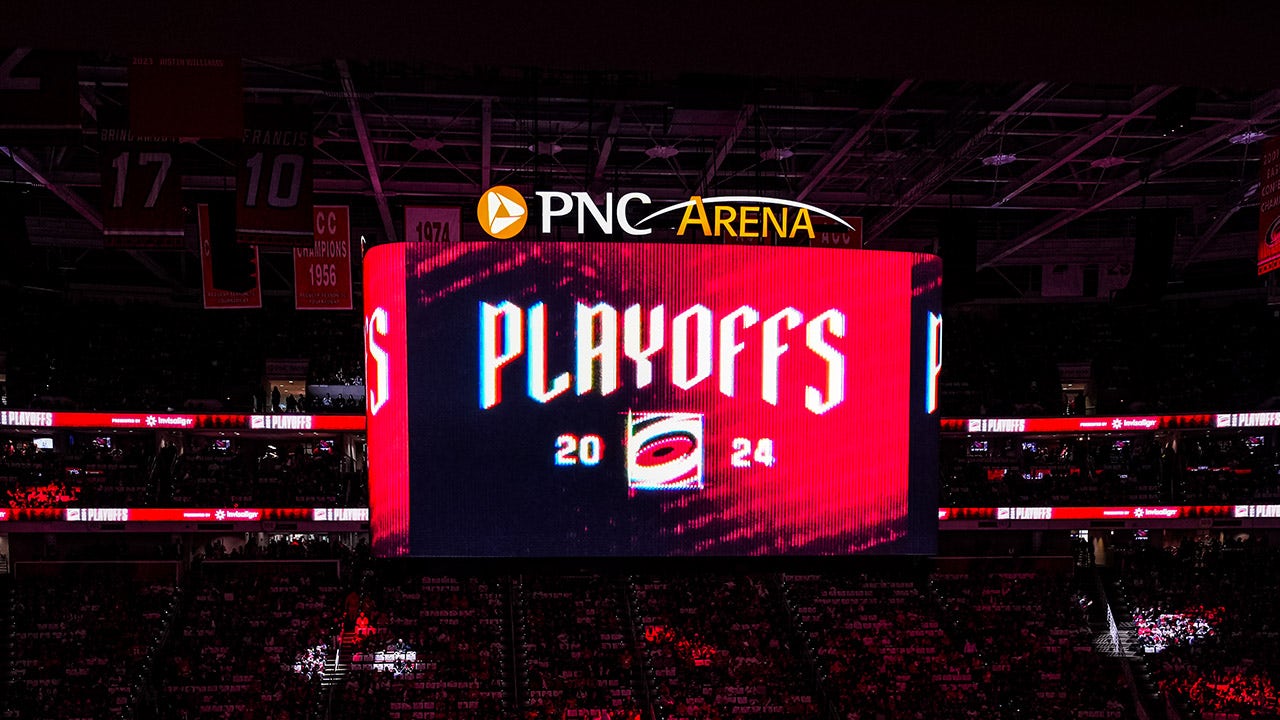
The Carolina Hurricanes are going the extra mile to make sure they have home-ice advantage in the second round of the Stanley Cup Playoffs.
The Hurricanes got a tough draw for the second round in facing the Presidents Trophy winner in the New York Rangers.
Despite that, Carolina actually is favored to not only win the series but win the Cup.
(Cato Cataldo/NHLI via Getty Images)
But the Rangers fan base is one of the largest out there. And the ‘Canes know that.
So, they are limiting ticket sales for their home games of the series to only local residents.
“PNC Arena is located in Raleigh, NC. Sales to this event will be restricted to residents of North Carolina, South Carolina and southern parts of Virginia,” says a disclaimer on social media. “Residency will be based on credit card billing address. Orders by residents outside North Carolina, South Carolina and southern Virginia will be canceled without notice and refunds given.”
Carolina hosts Games 3 and 4 of the series, and if necessary, Game 6.
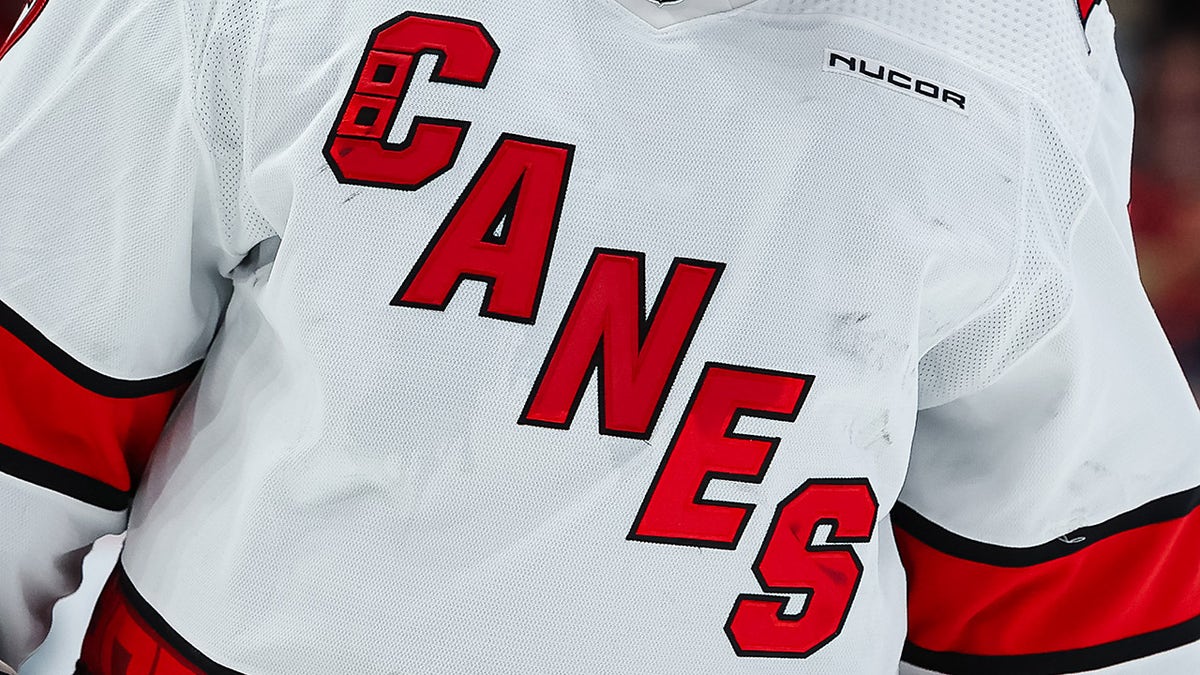
The Carolina Hurricanes are limiting ticket sales to local residents for home games in the playoff series against the New York Rangers. (Scott Taetsch/Getty Images/File)
LIGHTNING COACH APOLOGIZES FOR SAYING GOALIES ‘MIGHT AS WELL PUT SKIRTS ON’ AFTER BACKLASH
Rangers fans aren’t the only fan base from Madison Square Garden to recently be shut out of an opponent’s arena.
Philadelphia 76ers co-owners Josh Harris, David Blitzer and David Adelman, along with Fanatics CEO Michael Rubin, purchased 2,000 tickets to Thursday’s Game 6 in Philadelphia to give to local first responders and community groups.
That gesture came after Sixers star Joel Embiid turned heads when he said he was “disappointed” that New York Knicks fans had seemingly taken over Wells Fargo Center in Game 4. Rubin joked on X, formerly Twitter, that Philly fans “absolutely CANNOT let Knicks fans take over our arena again!!!”
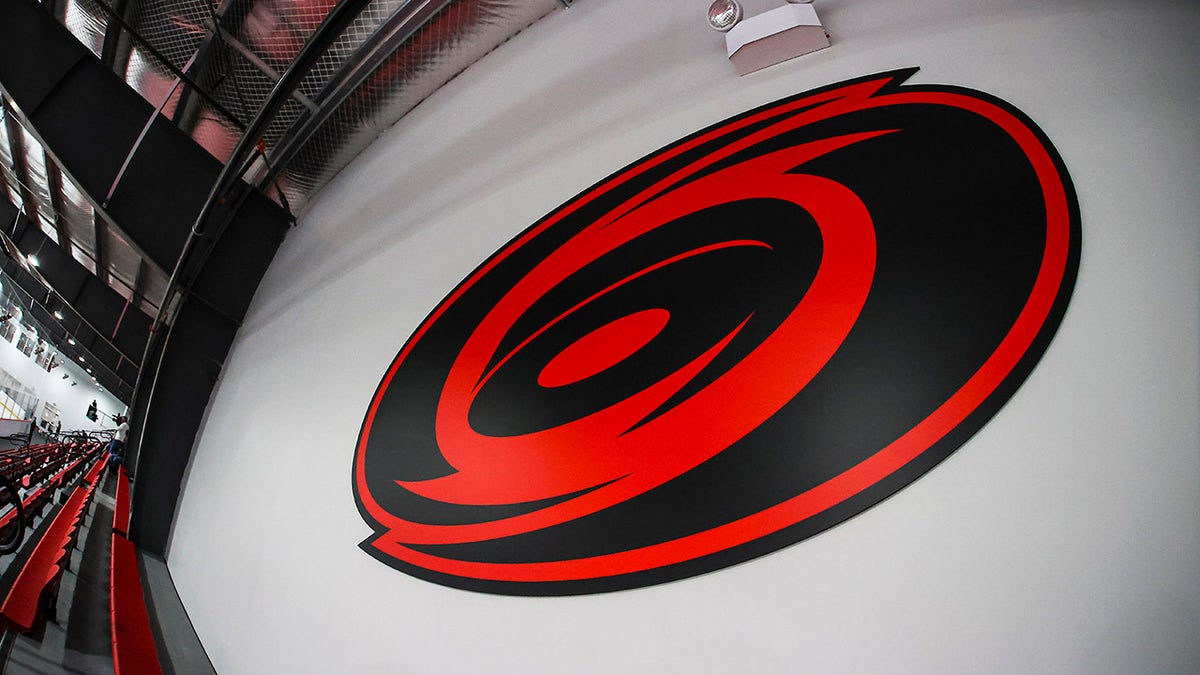
The Carolina Hurricanes are limiting ticket sales to local residents for home games in the playoff series against the New York Rangers. (Jaylynn Nash/Icon Sportswire via Getty Images via Getty Images/File)
Madison Square Garden prices tend to be higher than most, especially during the playoffs, so it makes sense why fans opt to travel, especially to Philadelphia, which is just a trip down the New Jersey Turnpike.
The dates for the series are still to be determined.
Follow Fox News Digital’s sports coverage on X, and subscribe to the Fox News Sports Huddle newsletter.
Sports
How hitting with runners in scoring position has been Shohei Ohtani's one Dodgers flaw
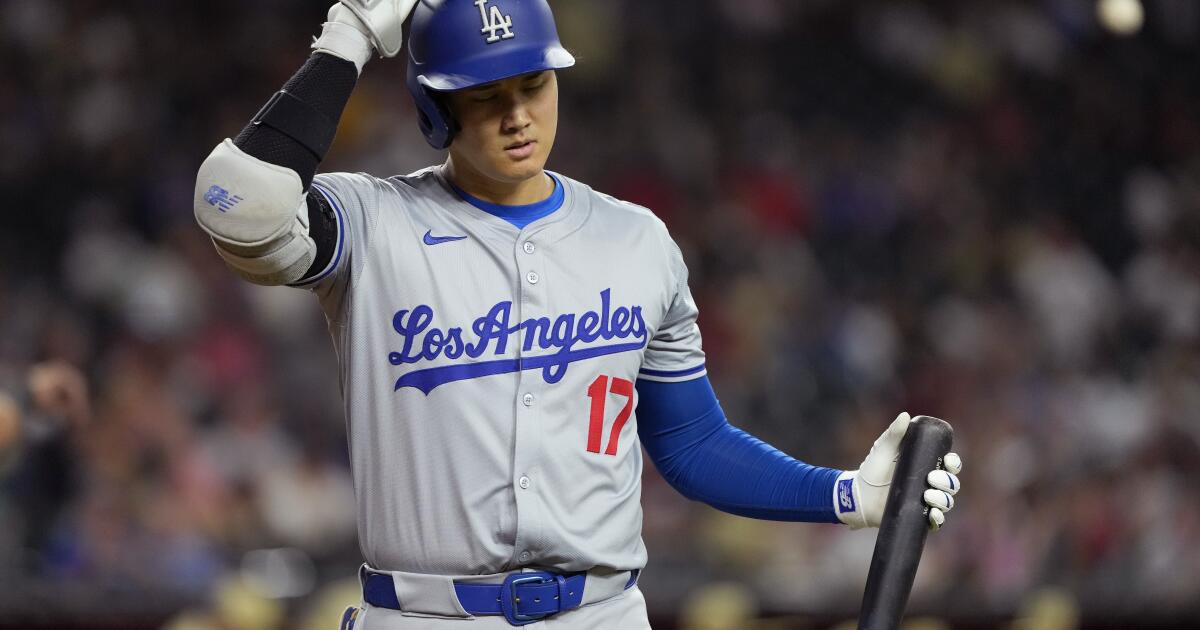
The timing was coincidental.
But, on Shohei Ohtani’s first off day as a Dodger, the discourse Wednesday centered on the one big struggle of his 2024 season — a weakness that had cropped up once again the night before.
When there hasn’t been a baserunner at second or third base season, Ohtani has been the best hitter in baseball. He is batting an MLB-best .398 in such spots. His .774 slugging percentage is more than 100 points better than all but two other players.
When the Dodgers need to start a rally, the $700 million signing is often their most potent spark.
However, with runners in scoring position over the first month of the year, the slugger’s production has unexpectedly cratered, leading to a trend of frustratingly empty key at-bats.
With RISP, Ohtani is batting just .184 (seven for 38) with a .237 slugging percentage. Of the 14 big leaguers with at least 35 such at-bats, he is the only one with less than 10 RBIs. And, somewhat amazingly, he has driven more runs without RISP (10, including all seven of his home runs) than with RISP (nine).
The two latest examples came in a Tuesday loss to the Arizona Diamondbacks, when Ohtani struck out in the fifth inning with runners on second and third, then almost hit into an inning-ending double-play in the top of the 10th, having to use his speed to beat a throw to first and prolong the inning — one that still resulted in only one Dodgers run, before the Diamondbacks scored twice in the bottom half for a walk-off win.
“Certainly, there was some opportunities,” manager Dave Roberts said a day later, after — in what he insisted was an unrelated decision — deciding to give Ohtani his first day off. “But, I don’t want to say [it was him taking a] step back.”
Maybe in the context of this season, it wasn’t.
But, compared to his past three seasons with the Angels, when producing in situational at-bats was one of the two-time MVP‘s signature strengths, Ohtani’s struggles this year have thus far been confounding.
From 2021-2023, Ohtani was one of MLB’s best hitters with RISP. He batted .305 in those situations, the 22nd-best mark in the majors in that span. He slugged .689, easily the best mark among big-league hitters.
On the surface, the explanations for this year’s regression seem simple.
Compared to his non-RISP at-bats, Ohtani swings more frequently (56% with RISP, 43% without) and chases more often (31.5% with RISP, 26.5% without) with a chance to drive in runs.
It has led to shorter at-bats (he sees 3.5 pitchers per plate appearance with RISP, and 4.2 without) and, despite a decreased in strikeouts, an also slightly lower walk rate (9.1% with RISP, 10.5% without).
Whenever he does come up empty on a pitch outside the strike zone, it’s easy for fans and media members to identify in real-time.
“Shohei is as aggressive as those bees were,” Roberts said, jokingly referring to the swarm of bees that delayed Tuesday’s game. “Hitters [like him] want to hit … They want to hit in big spots.”
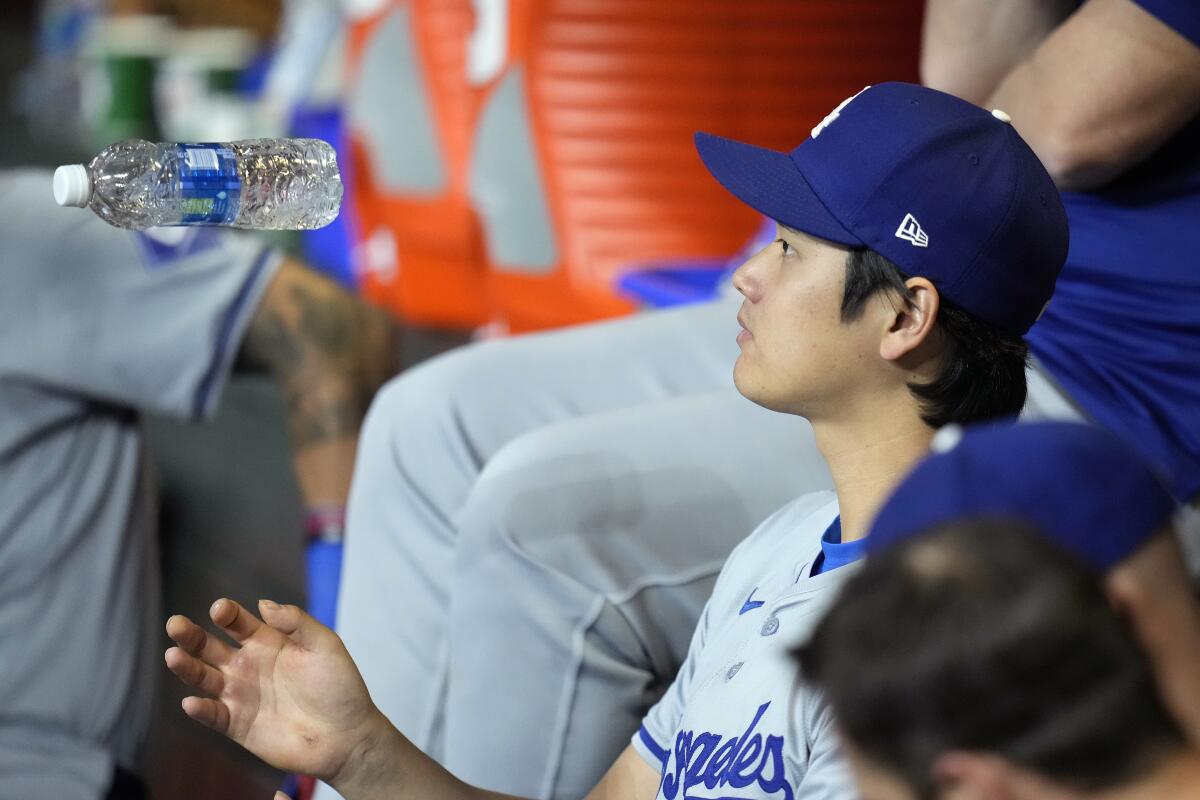
Shohei Ohtani was given a day off for the first time this season, though Dodgers manager Dave Roberts was quick to point out it wasn’t because of his struggles with runners in scoring position.
(Ross D. Franklin / Associated Press)
It’s just that, this year, he almost seemed to want to do so too badly too many times.
There is an important caveat to all this, though: Ohtani’s approach with RISP this year hasn’t seemed to differ much from what he did in Anaheim.
From 2021 to 2023, Ohtani swung with RISP almost 53% of the time, only slightly less than this year. He would chase pitches at a 35% rate, slightly more often than the opening month of this season.
Such aggression is evidently by design. When asked about his RISP approach a couple weeks ago, Ohtani acknowledged through his interpreter that “the zone that I am swinging is a little bit larger with runners in scoring position.”
Opponents, after all, are more likely to pitch around him with RISP. If he wants to “move the ball forward,” as Roberts likes to say, it requires hitting pitches not directly over the heart of the plate.
“Certainly,” Roberts said, “he feels like he’s the best option to drive in a run.”
Of course, as the manager conceded, that does give pitchers a way to exploit Ohtani, tempting him with offerings out of the zone he sometimes shouldn’t be chasing.
Yet, at the same time, Roberts said, “I think his DNA … is to want to swing the bat.” Which, in the manager’s opinion, “is still a good thing.”
So how does Ohtani get better with runners in scoring position?
Given his track record, the answer might not be as obvious as being more selective with his approach at the plate.
Sure, Roberts said, Ohtani needs to keep improving his plate discipline — a trait he has highlighted as a key to the slugger’s strong start to the year overall.
But, just as important, is for Ohtani to simply execute better when swinging outside the zone, and replicate the productive aggressiveness he honed in years past.
That could mean more consistency with his mechanics. It could mean trying to hit the ball the other way more often, something he has not done nearly as much with RISP this year compared to the past.
Whatever the case, his approach in clutch moments will continue to attract scrutiny — serving as the one place this year to poke holes in his game.
“I did see some more expanding than he has done in let’s say the last, seven to 10 games,” Roberts said of an ever-evolving process. “But I think in general, he’s been in a good spot.”
-

 News1 week ago
News1 week agoLarry Webb’s deathbed confession solves 2000 cold case murder of Susan and Natasha Carter, 10, whose remains were found hours after he died
-

 Education1 week ago
Education1 week agoVideo: Dozens of Yale Students Arrested as Campus Protests Spread
-

 World1 week ago
World1 week agoHaiti Prime Minister Ariel Henry resigns, transitional council takes power
-

 News1 week ago
News1 week agoFirst cargo ship passes through new channel since Baltimore bridge collapse
-

 World1 week ago
World1 week agoUS secretly sent long-range ATACMS weapons to Ukraine
-

 World1 week ago
World1 week agoSpanish PM Pedro Sanchez suspends public duties to 'reflect'
-

 News1 week ago
News1 week agoAmerican Airlines passenger alleges discrimination over use of first-class restroom
-

 World1 week ago
World1 week agoAsia bears biggest climate-change brunt amid extreme weather: WMO
